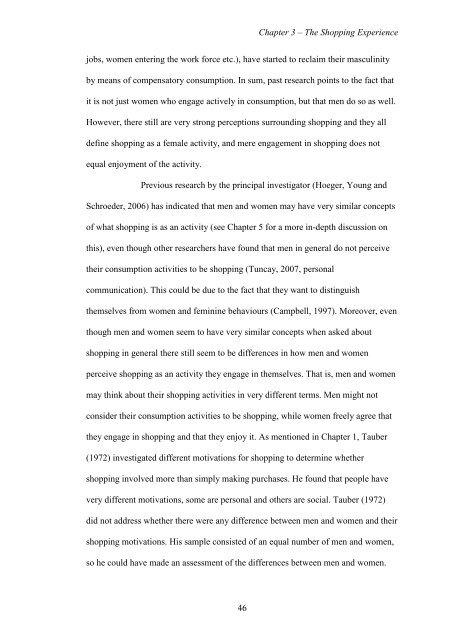CHAPTER 1 - University of Exeter
CHAPTER 1 - University of Exeter
CHAPTER 1 - University of Exeter
Create successful ePaper yourself
Turn your PDF publications into a flip-book with our unique Google optimized e-Paper software.
46<br />
Chapter 3 – The Shopping Experience<br />
jobs, women entering the work force etc.), have started to reclaim their masculinity<br />
by means <strong>of</strong> compensatory consumption. In sum, past research points to the fact that<br />
it is not just women who engage actively in consumption, but that men do so as well.<br />
However, there still are very strong perceptions surrounding shopping and they all<br />
define shopping as a female activity, and mere engagement in shopping does not<br />
equal enjoyment <strong>of</strong> the activity.<br />
Previous research by the principal investigator (Hoeger, Young and<br />
Schroeder, 2006) has indicated that men and women may have very similar concepts<br />
<strong>of</strong> what shopping is as an activity (see Chapter 5 for a more in-depth discussion on<br />
this), even though other researchers have found that men in general do not perceive<br />
their consumption activities to be shopping (Tuncay, 2007, personal<br />
communication). This could be due to the fact that they want to distinguish<br />
themselves from women and feminine behaviours (Campbell, 1997). Moreover, even<br />
though men and women seem to have very similar concepts when asked about<br />
shopping in general there still seem to be differences in how men and women<br />
perceive shopping as an activity they engage in themselves. That is, men and women<br />
may think about their shopping activities in very different terms. Men might not<br />
consider their consumption activities to be shopping, while women freely agree that<br />
they engage in shopping and that they enjoy it. As mentioned in Chapter 1, Tauber<br />
(1972) investigated different motivations for shopping to determine whether<br />
shopping involved more than simply making purchases. He found that people have<br />
very different motivations, some are personal and others are social. Tauber (1972)<br />
did not address whether there were any difference between men and women and their<br />
shopping motivations. His sample consisted <strong>of</strong> an equal number <strong>of</strong> men and women,<br />
so he could have made an assessment <strong>of</strong> the differences between men and women.
















